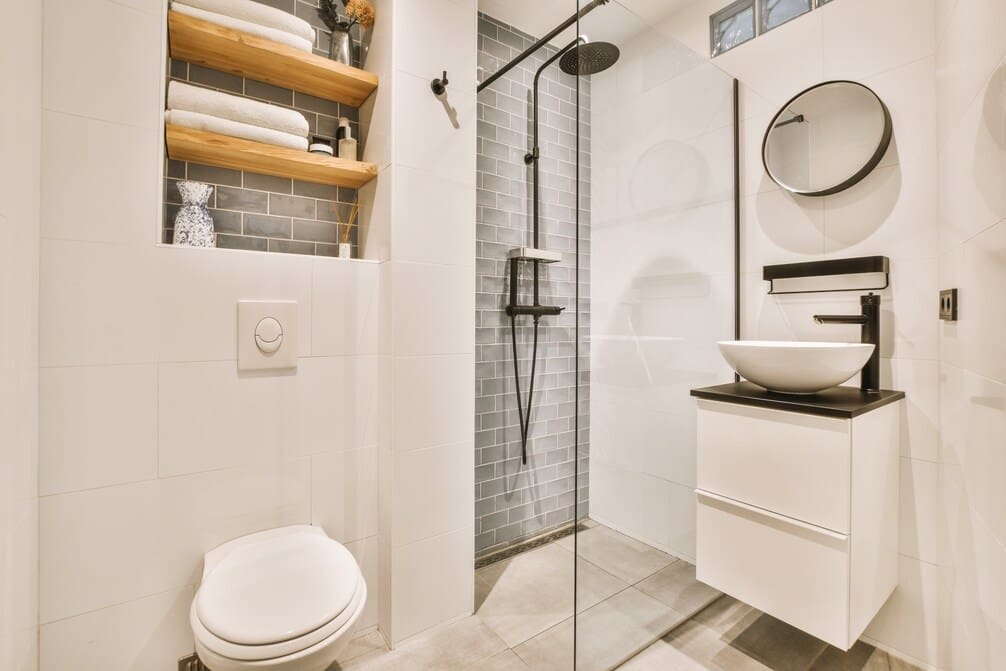Embarking on the journey to cleanse your shower head is akin to setting sail across a sea of grime and lime, where the treasure lies in the sparkle and unimpeded flow you’ll uncover. You’ll start by assessing the battlefield, determining if your shower head’s condition warrants a full removal or if a surface cleanse will suffice.
Key Takeaways
- Inspect shower head for hard water and mineral deposits
- Use heavily distilled white vinegar soak technique to dissolve mineral buildup
- Scrub with baking soda and lemon juice for stubborn stains
- Rinse thoroughly and reassemble carefully, checking for leaks and blocked spray holes.
Inspect and Prepare
Before diving into the cleaning process, it’s crucial to first assess the severity of your showerhead’s blockage and decide whether removing it for a thorough cleanse is necessary. You’ll want to inspect and prepare carefully, especially if your shower head is finished in a material that could be damaged by tools. Start by examining the shower arm and the head itself for signs of hard water, mineral deposits, and calcium deposits. These build-ups can significantly impact water pressure and flow, making your showers less efficient and less enjoyable.
If the deposits are extensive, you might need to remove the shower head for a more in-depth cleaning. However, for surface-level build-up, a simpler approach using a rubber band, a plastic bag, and heavily distilled white vinegar can do wonders without the need for detachment. This method is especially useful for clearing out minor blockages and restoring water flow.
Additionally, it’s important to check for mold and mildew, as these can pose health risks and affect the shower’s cleanliness. If you spot any, removing the shower head for a comprehensive cleaning might be unavoidable. Preparing adequately for the cleaning process ensures you tackle all potential issues, keeping your shower experience pleasant and hygienic.
Heavily distilled white Vinegar Soak Technique
To effectively dissolve mineral deposits clogging your shower head, consider the heavily distilled white vinegar soak technique, a simple yet powerful cleaning method.
Start by filling a gallon-size zipper plastic bag halfway with heavily distilled white vinegar. This natural acid is exceptional at breaking down calcium and other minerals that can block your showerhead’s nozzles.
Carefully attach the bag to the showerhead, ensuring it’s fully submerged, using a rubber band or zip tie to secure it in place. For standard showerheads, let this setup sit for an hour to deep clean the nozzles. However, if you’ve got a brass showerhead, limit the soak to 30 minutes to avoid damage. Steer clear of this method for nickel-coated showerheads, as vinegar can be harsh on them; a baking soda and lemon juice mix is a safer alternative.
After the soaking time has elapsed, remove the bag and grab a toothbrush to scrub away any loosened mineral deposits. Rinse the showerhead with hot water to wash away the remnants.
For stubborn mineral buildup, take out the filter screen and give it a separate soak in vinegar or a descaler solution for a thorough clean.
Scrubbing the Buildup
After soaking your shower head in vinegar, it’s crucial to tackle any remaining mineral buildup by scrubbing the nozzles and surrounding areas thoroughly. Grab an old toothbrush as it’s your best ally in targeting the hard-to-reach spots. Gently yet firmly, brush away the loosened mineral buildup, consisting mainly of calcium and magnesium. These elements are notorious for clogging your shower head and affecting water flow.
For stubborn areas where vinegar alone doesn’t do the trick, make a paste using baking soda and lemon juice. This mixture is particularly effective against hard water stains and soap scum, providing the abrasive action needed without damaging your shower head. Apply the paste, let it sit for a few minutes, and then resume scrubbing. The acidity of the lemon juice helps dissolve the buildup, while the baking soda acts as a mild abrasive.
If you’re dealing with rust or signs of mold and mildew, consider using a specialized rust remover or a mildew cleaner. Be sure to follow the product instructions carefully to avoid damaging your clean showerhead.
With persistent effort and the right tools, scrubbing the buildup can restore your shower head’s performance and aesthetics, ensuring a sparkling clean finish.
Rinsing Thoroughly
Following the vinegar soak, ensure you rinse the shower head thoroughly with water, meticulously clearing any residual debris from the nozzles and crevices. This step is crucial for a thorough cleaning, as it helps remove the loosened deposits and mineral buildup that the vinegar-filled bag has worked to dissolve. After soaking, gently remove the shower head from the bag, being careful not to spill any remaining vinegar solution.
Next, turn on the water to flush out the interior channels of the shower head. This action forces out any particles or mineral deposits that might still be clinging inside. Pay special attention to the small nozzles, using a steady stream of water to dislodge any remaining debris. If needed, use a soft cloth or sponge to gently wipe the surface of the shower head, ensuring that every spot is addressed.
Check the shower head closely for any signs of lingering mineral deposits. If you spot any, you may need to repeat the rinsing process to ensure the removal is complete. Once satisfied, dry the shower head thoroughly with a clean towel or let it air dry before reattaching it to the shower arm. This final step prevents water spots and ensures your shower head isn’t only clean but also shines like new.
Reassembling and Testing
Having thoroughly rinsed and dried your shower head, it’s now time to reattach it and ensure everything functions correctly. Start by carefully screwing the shower head back onto its fixture. If you’re using a wrench, wrap the connector in a cloth to prevent scratches. Make sure it’s secure but don’t over-tighten, as this could damage the threads.
Once reassembled, slowly turn on the water supply to avoid a sudden rush that could dislodge any remaining debris inside the shower head. Watch for leaks around the connection. If you spot any, tighten the head a bit more, but remember, gentle does it.
Now, it’s crucial to check for blocked spray holes. Turn the water to its full force and observe the spray pattern. If you notice uneven or no water flow from some holes, CLR Calcium, Lime & Rust Remover can help. Just make sure it’s safe for your shower head’s material.
Frequently Asked Questions
How Do I Make My Shower Sparkle?
To make your shower sparkle, you’ll need to tackle mineral deposits. Use a mix of heavily distilled white vinegar and water, scrubbing surfaces and soaking the showerhead. Avoid bleach, clean monthly, and assess blockages before starting.
How Do You Detox a Shower Head?
To detox your shower head, you’ll need to soak it in heavily distilled white vinegar for an hour to break down mineral deposits. Ensure you clean it monthly to prevent bacterial buildup and maintain water pressure.
How Do You Clean a Shower Head With Soda Crystals?
To clean your shower head with soda crystals, dissolve them in hot water. Submerge the shower head in this solution for an hour, scrub with a brush, rinse well, and dry it off for sparkle.
What Is the Best Solution to Descale a Shower Head?
The best solution to descale your shower head is a mixture of heavily distilled white vinegar and water. Soak it for at least 30 minutes for tough deposits. Avoid bleach to prevent damage.





